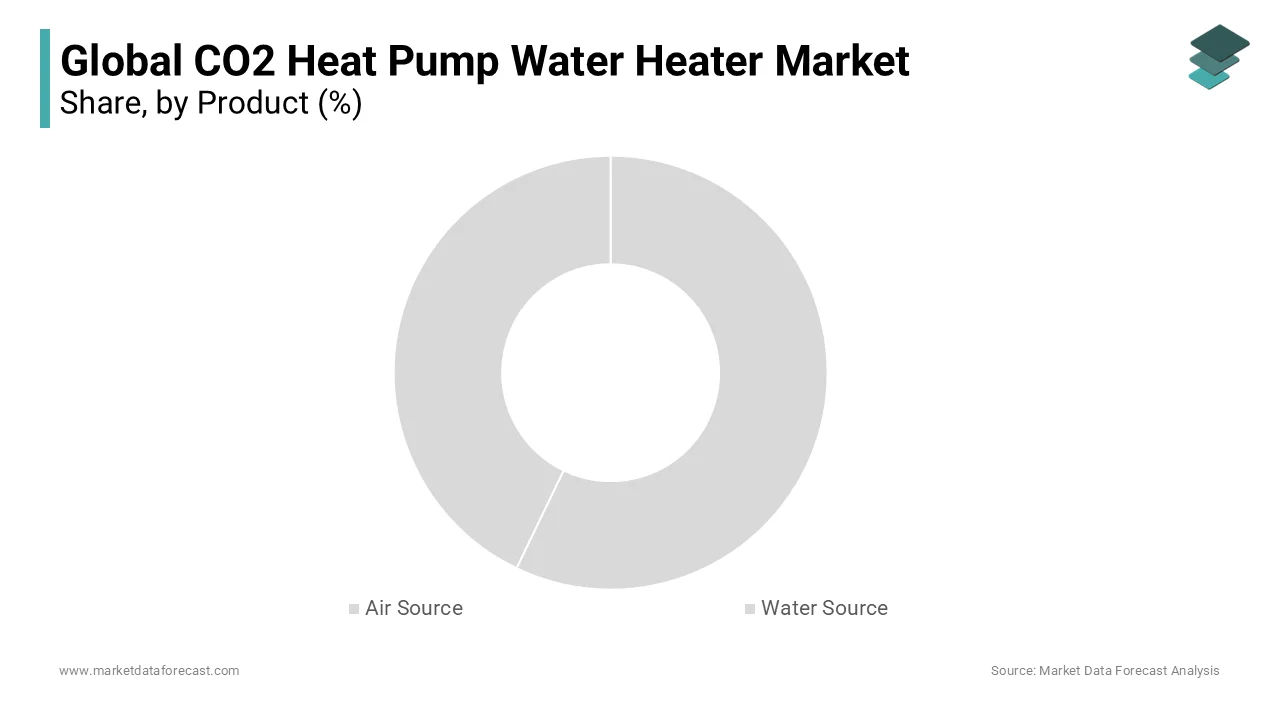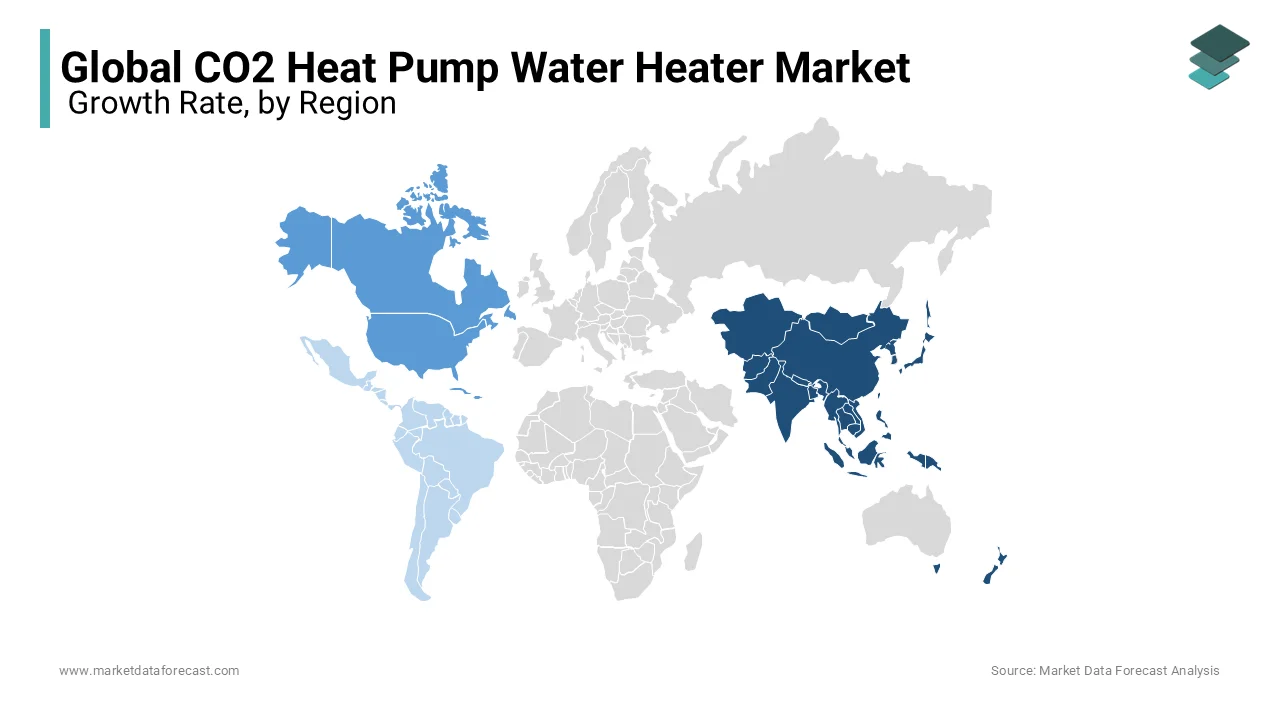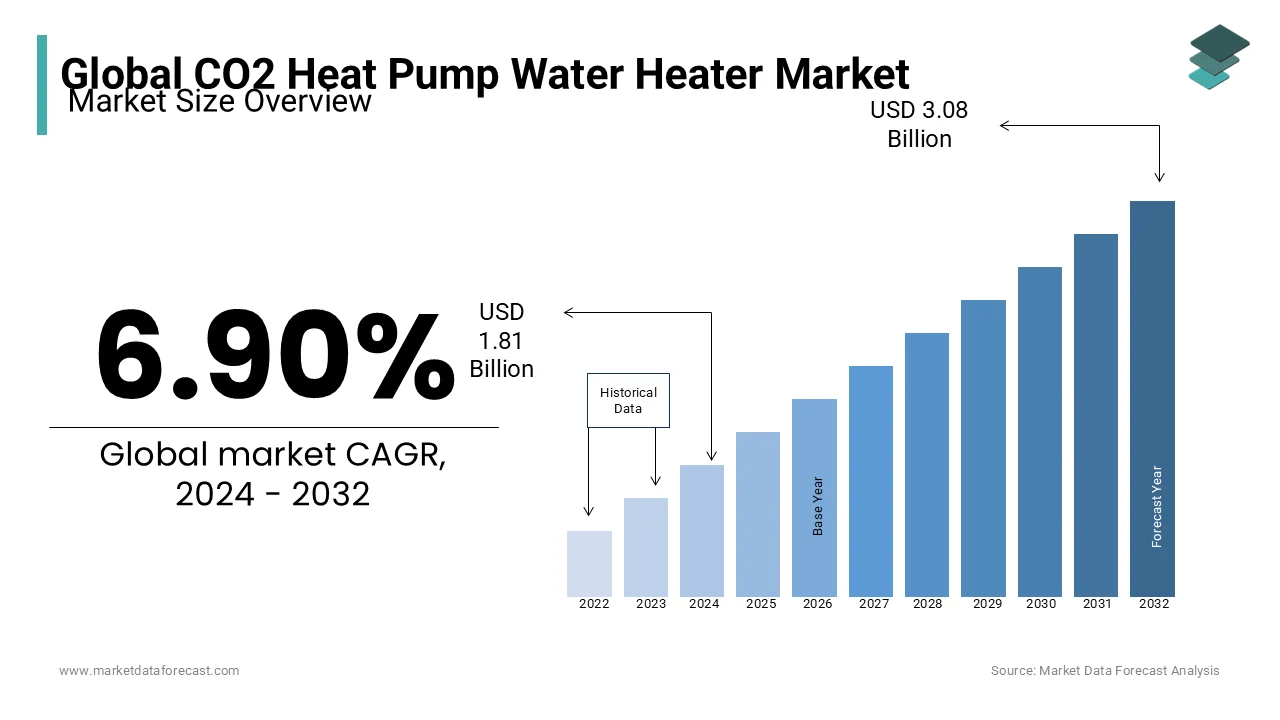Global CO2 Heat Pump Water Heater Market Research Report - Segmentation by Product (Air Source and Water Source); By Application (Residential, Commercial and Industrial) and Region (North America, Europe, Asia-Pacific, Latin America, Middle East and Africa) – Industry Analysis (2024 to 2032).
Global CO2 Heat Pump Water Heater Market Size (2024-2032):
The Global CO2 Heat Pump Water Heater Market size was valued at US$ 1.69 billion in 2023 and is anticipated to reach US$ 3.08 billion by 2032 from US$ 1.81 billion in 2024 and increase at a CAGR of 6.90% between 2024 and 2032.
The system has several advantages over other heat pump water heaters, including a reduction in primary energy usage of more than 75%. In addition, the rising demand for energy-efficient heaters in developed countries like Europe and Japan propels the CO2 Heat Pump Water Heater Market forward. Over the projected period, the increasing demand for HPWH from commercial and residential areas and district heating projects is expected to give profitable chances for the CO2 heat pump water heater market to develop.
MARKET DRIVERS
The increasing demand for energy-efficient heaters in emerging economies is the primary factor responsible for the global CO2 heat pump water heater market growth during the forecast period.
Similar to refrigerators, a CO2 heat pump water heater is introduced as a compressor. Instead of discharging heat into the atmosphere, the HPWH collects heat from the environment and pumps it into a water tank. When compared to typical HPWH systems that utilize propane or HFC as a working fluid, the HPWH system using CO2 as a working fluid can achieve a 20% higher COP. Heat pump water heaters are ideal for less hot water applications, such as in small business operations and the residential sector, including single-family residences and multi-family structures. This heater's 10–20kW segment is simple to operate and has high operational efficiency. Nursing homes, hotels, hospitals, sports facilities, and residential constructions all use these heaters daily. Because of their environmental and cost-saving benefits, these heat pumps have acquired widespread acceptance and approval.
Furthermore, government initiatives in several nations are supporting the growing need for geothermal heat pumps. Again, one of the most promising solutions for reducing greenhouse gas emissions is a heat pump water heater. Through aerothermal and geothermal technology, a heat pump water heater gives an energy-efficient approach to supply heating. As a result, adopting heat pump water heater systems instead of fossil fuel-based systems can dramatically lower carbon emissions coupled with energy use and generation. Nonetheless, technological improvements, the Internet of Things (IoT)-enabled heat pump water heater systems, and untapped potential in emerging countries point to positive growth prospects. Moreover, the increasing number of heat pump water heater installations in commercial, industrial, and residential segments acts as a crucial factor in fueling the global CO2 heat pump water heater market growth in the upcoming years.
MARKET RESTRAINTS
All end-user sectors are unaware of heat pump water heaters' cost efficiency, energy efficiency, and environmental benefits.
This is because they are generally thought to be costly. These are the potential limitations to the global CO2 Heat Pump Water Heater Market's overall growth. In addition, a lack of awareness regarding the uses of heat pump water heaters in emerging economies hinders the global CO2 heat pump water heater market growth during 2021-26. Furthermore, a new generation of CO2 heat pumps generates much higher temperatures and avoids the high global warming potential of standard refrigerants.
On the other hand, heat pumps are of high cost and are difficult to install. Moreover, heat pumps raise more issues in cold weather and can damage the system. Therefore, in cold weather, heat pumps cannot generate high efficiency.
Moreover, heat pumps rely on electricity to operate and have a high coefficient of performance. The installation process of heat pumps requires enough work and disruptions to the house and the garden. Moreover, heat pumps are expensive, which is the most challenging to install. These are some of the factors responsible for hampering the global CO2 heat pump water heater market during the foreseen period.
REPORT COVERAGE
|
REPORT METRIC |
DETAILS |
|
Market Size Available |
2023 to 2032 |
|
Base Year |
2023 |
|
Forecast Period |
2024 to 2032 |
|
CAGR |
6.90% |
|
Segments Covered |
By Product, By Application, and Region. |
|
Various Analyses Covered |
Global, Regional & Country Level Analysis, Segment-Level Analysis, DROC, PESTLE Analysis, Porter’s Five Forces Analysis, Competitive Landscape, Analyst Overview of Investment Opportunities |
|
Regions Covered |
North America, Europe, APAC, Latin America, Middle East & Africa. |
|
Market Leaders Profiled |
Sanden, Mitsubishi, DENSO, AAON, DunAn Group, enEX, Sujing Group, Nihon Itomic, Daikin, Zero Energy Project, and Others. |
SEGMENTAL ANALYSIS
Global CO2 Heat Pump Water Heater Market Analysis By Product

Based on the product, the air source segment will play a dominant role in the global CO2 heat pump water heater market in the near future. Most residential sectors utilize air sources due to their lower installation cost and eco-friendly technology, which further propels the global CO2 heat pump water heater market growth. The energy for heating is extracted from the air by an air source heat pump water heater. Instead of using a fluid-like ground or rainfall, this heat pump water heater is usually situated outside and absorbs thermal energy from the environment. In colder areas, the technique of absorbing outside heat uses less fuel than typical electric resistance heating systems and gas boilers, resulting in lower electricity usage and easier market penetration.
On the other hand, the water source segment tends to grow with the highest CAGR in the market. Depending on whether there is power available for heating, water source heat pumps absorb thermal energy from water, then are pumped between a compressor/condenser unit and an electric heater core. Thus, they work in the same way that air source heat pump water heaters do, but without the need for additional components like fans or ducting, making them simple to install and maintain even in small spaces. This characteristic makes it appropriate for residential applications where installation requirements could be complex if not planned beforehand.
Global CO2 Heat Pump Water Heater Market Analysis By Application
Based on application, the residential sector held the highest global CO2 heat pump water heater market share because of its energy-efficiency technology and several government subsidies to increase the demand for heat pump water heaters. Electric resistance heating is used in the home use of CO2 heat pump water heaters, using an electrically powered fan to circulate the air, which is then cooled by passing through a coil before being vented back into the room. Depending on the local environment and weather circumstances, it can be utilized as a primary or secondary house heating source. In addition, depending on space constraints and hot water demand, the appliance may be positioned at a central location or on each building floor.
REGIONAL ANALYSIS

Asia Pacific is the largest global CO2 heat pump water heater market owing to the increasing government initiatives to propel the demand for heat pump water heaters and rising the use of renewable energy and energy-efficient products.
North America is estimated to grow with the highest CAGR in the global CO2 heat pump water heater market due to the several changes made by the emerging economies including U.S. and Canada, through their effects on lowering the CO2 emissions.
Latin America is anticipated to have significant global CO2 heat pump water heater market revenue owing to the growing environmental awareness and modified infrastructure to lower the emissions of greenhouse gases.
KEY PLAYERS IN THE GLOBAL CO2 HEAT PUMP WATER HEATER MARKET
Companies playing a prominent role in the global CO2 heat pump water heater market include Sanden, Mitsubishi, DENSO, AAON, DunAn Group, enEX, Sujing Group, Nihon Itomic, Daikin, Zero Energy Project, and Others.
RECENT HAPPENINGS IN THE GLOBAL CO2 HEAT PUMP WATER HEATER MARKET
-
Mitsubishi introduced the lossnay mechanical ventilation for residential use, which provides clean, healthy, and fresh air to homes. It is designed especially for the U.K. housing market. It can be used in kitchens, utility rooms, bathrooms, etc. It has low noise levels and is best-suitable for residential purposes.
-
On August 5th, 2021, Daikin introduced Daikin Applied's Pathfinder AWV, an integrated water-side economizer with free cooling advantages, to an air-cooled chiller. Due to its benefits, it is awarded as a comfort product of the year.
DETAILED SEGMENTATION OF THE GLOBAL CO2 HEAT PUMP WATER HEATER MARKET INCLUDED IN THIS REPORT
This research report on the global CO2 heat pump water heater market has been segmented and sub-segmented based on product, application, and region.
By Product
- Air Source
- Water Source
By Application
- Residential
- Commercial
- Industrial
By Region
- North America
- Europe
- Asia Pacific
- Latin America
- Middle East & Africa
Frequently Asked Questions
What is driving the growth of the global CO₂ heat pump water heater market?
The growth of the global CO₂ heat pump water heater market is driven by increasing awareness of energy-efficient and environmentally friendly heating solutions. Governments worldwide are incentivizing the adoption of CO₂ heat pump technology as part of carbon reduction initiatives, making it a preferred option over traditional heating systems, especially in residential and commercial sectors.
What are the primary applications of CO₂ heat pump water heaters?
CO₂ heat pump water heaters are mainly used in residential, commercial, and industrial settings. In residential applications, they are popular for domestic hot water supply. Commercially, they are employed in hotels, hospitals, and public facilities, and in industrial applications, they serve hot water needs in manufacturing processes.
What are the anticipated trends in the CO₂ heat pump water heater market over the next decade?
The CO₂ heat pump water heater market is expected to see increased adoption due to advances in technology, reductions in production costs, and stronger environmental policies globally. The trend toward net-zero emissions and sustainable energy solutions will further boost demand, with emerging markets also contributing to growth.
What is the outlook for investment in the CO₂ heat pump water heater market?
Investment in the CO₂ heat pump water heater market is projected to grow as companies and governments invest in sustainable infrastructure. With increasing demand for renewable energy systems and the push for carbon neutrality, this market will likely attract significant investment from both public and private sectors worldwide.
Related Reports
Access the study in MULTIPLE FORMATS
Purchase options starting from $ 2500
Didn’t find what you’re looking for?
TALK TO OUR ANALYST TEAM
Need something within your budget?
NO WORRIES! WE GOT YOU COVERED!
Call us on: +1 888 702 9696 (U.S Toll Free)
Write to us: [email protected]
